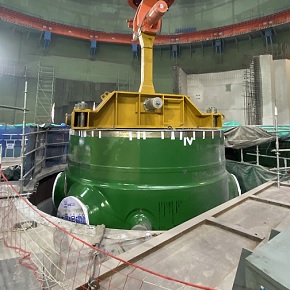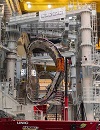MOX-fuel
Rosatom manufactures nitride and oxide uranium-plutonium fuels for the BN-1200 fast reactor
ROSATOM starts testing MOX fuel for VVER reactors
 AtomExpo-2022: raw materials for NFC
AtomExpo-2022: raw materials for NFC
On November 21-22, 2022, the XII ATOMEXPO-2022 International Forum was held at the Sirius Center in Sochi. The forum was attended by over 3,000 specialists and guests from Russia, as well as 65 countries of the near and far abroad: representatives of business, government agencies, international organizations.
Several round tables were organized within the framework of the forum. One of it was devoted to the issues of raw materials for nuclear energy.
A characteristic feature of the current stage of development of the nuclear industry is a rational approach to the use of natural uranium resources. The centrifuge technologies have made the re-enrichment of depleted uranium real and commercially effective, and the...
BN-800 fast reactor undergoes the first full refueling with MOX fuel
 In 2022, the first Russian NPP power block running fully on renewable fuel is to be launched
In 2022, the first Russian NPP power block running fully on renewable fuel is to be launched
In 2022, the 4th power block of the Beloyarsk NPP with a BN-800 fast-neutron reactor will be the first one in the history of our country to fully switch to uranium- plutonium MOX fuel. This will be an important step towards closure of the nuclear fuel cycle.
The full-scale transition of the Beloyarsk NPP BN-800 reactor to having a reactor core fully loaded with uranium-plutonium MOX fuel is planned for H1 2021. Fuel assemblies containing MOX fuel will be placed into the core, accounting for one-third of the total number of assemblies.
Since the beginning of the 4th power block operation and until now, the BN-800 has been operating a hybrid core combining fuel assemblies with uranium oxide fuel and those with tablet and vibration-consolidated MOX fuel.
The first batch of MOX fuel was loaded into the reactor at the Beloyarsk NPP
TVEL will supply nuclear fuel for China CFR-600 fast-neutron reactor
Rosatom Launches Batch Production of MOX Fuel for Fast Neutron Reactor
NRC considers MOX factory construction license extension
China signed Framework Agreement with Belgium in MOX-fuel production
 Fast, thermal, dry, wet - notes of the eyewitness
Fast, thermal, dry, wet - notes of the eyewitness
At the end of November the second international scientific-technical conference on the theme Development of nuclear power on the basis of closed nuclear fuel cycle (NFC) with fast neutron reactors was held under the aegis Rosenergoatom. The simultaneous participation of both reactor physicists and NFC specialists became the spirit of this conference.
Although the speakers were invited in advance, the conference agenda envisaged open round-table discussion of presentations. International status of the conference first of all was due to participation of Frenchmen Bruno Sicard. The American delegation included people from the program for weapons-grade plutonium. It should be noted that the majority of foreign participants didn't demonstrate any activity at the meetings.
It was interesting for many of participants to hear the position of the French. Now the main criterion of Paris is the following - don't accumulate spent nuclear fuel (SNF). It is possible to achieve it only by reprocessing of spent fuel.
Five truths and untruths of Kirienko-Bodman Statement
Is it true that signing of Kirienko - Bodman joint statement is the successful for Russian energy nuclear complex?
It isn't true. Using the only (after decommission of BN-600 reactor) fast reactor BN-800 for utilization of weapons-grade plutonium will make difficult to work on closing nuclear fuel cycle (NFC), in particular, to restrict the opportunities of Russia for recycling reactor plutonium (accumulated in reactor), that, in its turn, to postpone resolving a problem of nuclear waste and conversion to use of almost unlimited resource base of 238U.
Was there damage to Russian civil nuclear sector interests? If yes - how serious it was - it would be estimated only after removal of security classification from the results of technical consultations between Russian and American experts.
Closed or excess
Strictly speaking, Russian atom doesn't need in BN-800 reactor. Sodium technologies serviceability in Russia is proven by multiyear experience of BN-600 reactor operation, but BN-800 reactor can't go to commercial level. Implementation of BN-800 reactor into closed fuel cycle - mastering of technologies for reprocessing spent nuclear fuel (SNF) of VVER reactors, fabrication of new fuel from them, reprocessing of SNF of BN-800 itself and other - should be priority of number 1 for this reactor.
But it is impossible to solve this task with simultaneous using BN-800 for weapons-grade plutonium utilization. And if decision about political usage of BN-800 reactor is adopted ultimately, Russia will have a risk to freeze its current interim state for two-three decades - excellent, the best fast reactor technologies in the world and absolutely no closed NFC.
 Massimo Salvatores: interest to fast reactors in France revives
Massimo Salvatores: interest to fast reactors in France revives
Yes, there is the long experience of successful using of the MOX fuel both in thermal reactors and in the fast reactors. It has been a big achievement for the MOX fuel in the last twenty-thirty years.
Of course, for future fast reactors it will be more challenges because somehow or other we are thinking on the introducing of all the transuranic elements including the minor actinides. Let point that the future fuel is more challenging. It implies the separation techniques for the reprocessing of fuel will be advanced. Also the fabrication of the future fuel will be something very challenging.
These questions are discussed on the international level. One typical example of the international cooperation is the Generation-IV international forum where these issues are widely discussed.
 Vladimir Kagramanian: Breeding Ratio Should Be Cheap
Vladimir Kagramanian: Breeding Ratio Should Be Cheap
There is a simple logic here. There are two competitive processes in fast reactor - burning of plutonium loaded and accumulation of new plutonium from 238U. If fraction of loaded plutonium is 20%, its burning is compensated due to accumulation, and energy is generated due to using natural 238U, the reserves of which are "unlimited". But if the content of plutonium is higher than the above-indicated border - 40-50% and more, the rate of plutonium destruction will exceed the rate of its accumulation from uranium. This reactor will become the reactor - burner of plutonium technologically bred, the reserves of which are small, in several times less than the reserves of natural 235U. It means that reactor itself, coolant, the core and other components will be the same both in reactor-breeder and in reactor-burner, but the relationship between physics processes will be different. The tasks, which these reactors will solve, also will be different. Naturally, economy and safety of these reactors will be also different. For example, reactor-burner will have more complicated fuel cycle, and it will be necessary to compensate a drastic drop in reactivity during fuel cycle in this reactor coreЕ
 Vladimir Kagramanian: I Feel Pity for the French
Vladimir Kagramanian: I Feel Pity for the French
I feel pity for the French, fallen into real a trap.
Fast reactor technologies and technologies of SNF reprocessing developed in France. The plant for chemical reprocessing of SNF of thermal reactors and fast reactor SuperPhenix were built. Construction of the new NPP with fast reactors for utilization of plutonium extracted from SNF of thermal reactors was scheduled. Everything went in this direction, but in 80-ies the needs in electricity in Europe began stabilizing due to increasing efficiency of electricity consumption. So the necessity of increasing capacity fell away. As a result, the French faced with the problem what to do with extracted plutonium?
A similar accumulation of extracted plutonium was acknowledged as inexpedient both in the UK and USSR (at RT-2 plant). Then the following idea had been arisen - in order to keep people and technologies, MOX-fuel can be started to use in existing light water reactors, and moreover, the adjacent Belgium has demonstrated this technology.
To Beat Weapon-Grade Plutonium Into Something?
In July 2000, the quantitative aspects of the agreement have been elaborated. It has been fixed at presidential level that the Russian Federation and United States of America would somehow or other eliminate 34 metric tons of weapon-grade plutonium each [3]. At the same time, Washington has reserved to himself the freedom of choice - either fabricate the MOX-fuel from the weapon-grade plutonium and burn it in the nuclear reactors or immobilize plutonium, i.e. seal cans of plutonium inside the vitrified high-level radioactive waste and put it for long-time geological storage.









